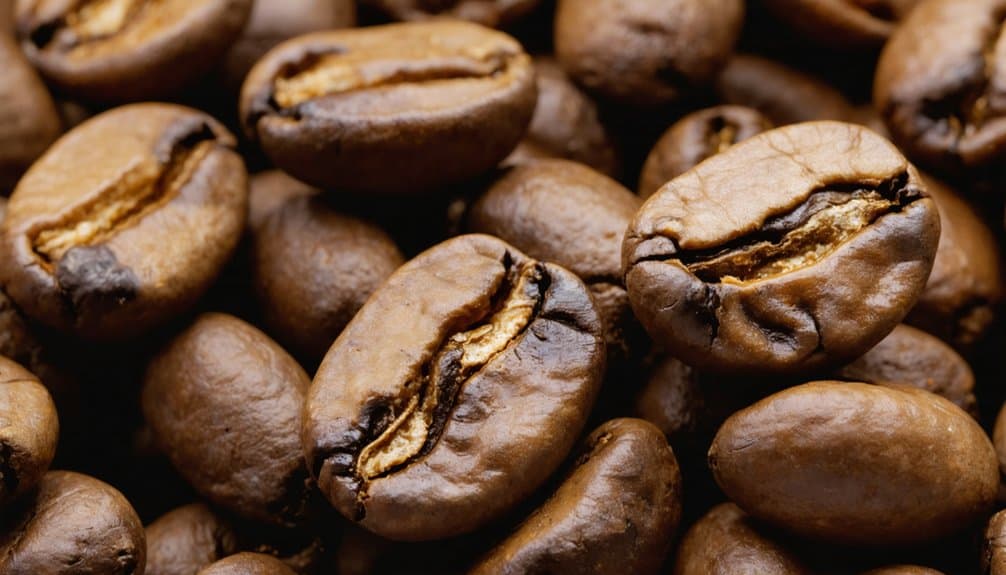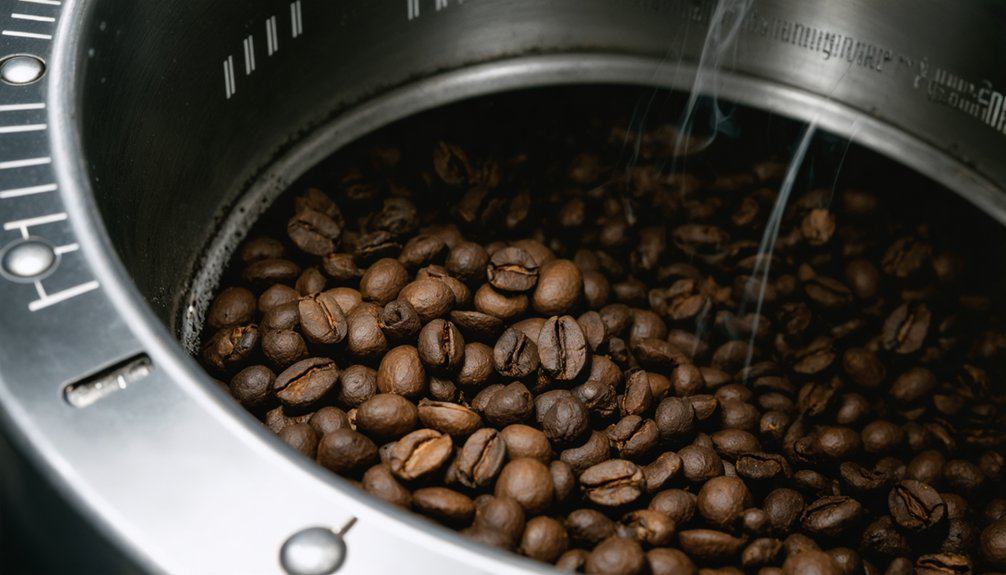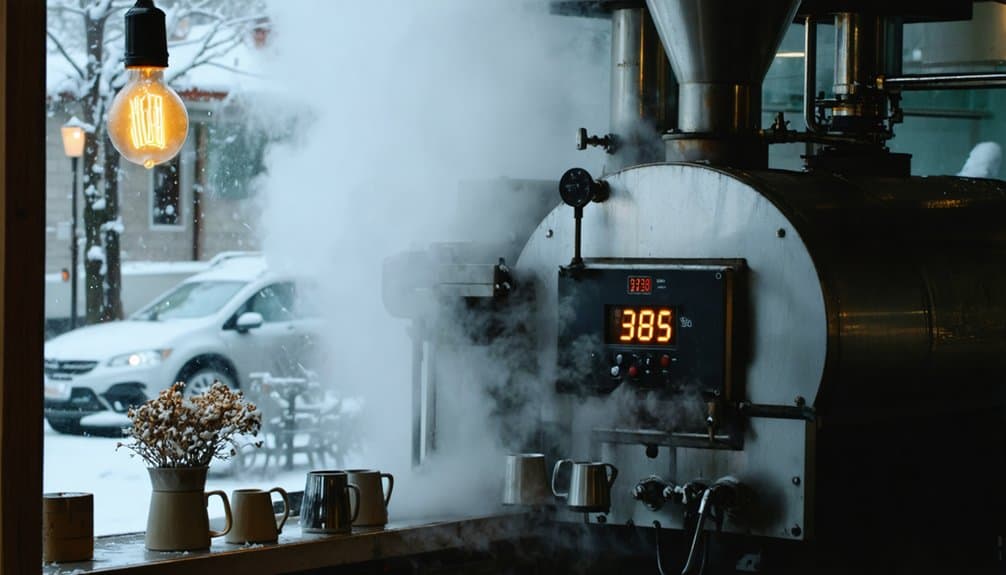Temperature control makes or breaks your coffee roasting because it drives the critical chemical transformations that develop flavor.
You’ll need precise management between 188-282°C, as beans undergo their initial crack at 200-202°C and secondary crack at 224-226°C
Your careful monitoring of Rate of Rise (RoR) prevents common issues like scorched exteriors and underdeveloped interiors.
Master temperature control, and you’ll reveal the full potential of every bean’s complex flavor profile.
Key Takeaways
- Precise temperature control between 188-282°C determines flavor development, with lower temperatures creating bright notes and higher temperatures producing smoky qualities.
- Inconsistent heat exposure leads to uneven bean development, resulting in scorched exteriors and underdeveloped interiors that ruin flavor profiles.
- The Rate of Rise (RoR) must remain steady throughout roasting to ensure proper flavor development and prevent both underdevelopment and scorching.
- Critical chemical changes occur at specific temperatures, with first crack at 200-202°C and second crack at 224-226°C, defining roast levels.
- Environmental factors affect roasting temperatures, requiring adjustments to achieve consistent results across different weather conditions and equipment types.
The Science Behind Perfect Roasting Temperatures

In regards to achieving the perfect coffee roast, understanding temperature control is vital to the entire process.
Your roasting odyssey begins at 81°C when the beans start their transformation, progressing through significant temperature points that’ll define your coffee’s character.
You’ll witness the vital initial crack at 200-202°C, where the Maillard reaction creates complex flavors by combining amino acids and sugars.
As you approach 224-226°C, you’ll hear the second crack, signaling darker territory.
The temperature range between 188-282°C is your canvas, where lower temperatures produce bright, fruity notes, while higher ones develop those rich, smoky qualities.
Drum speed optimization prevents uneven roasting and ensures consistent heat exposure throughout the batch.
Essential Temperature Monitoring Tools and Techniques
When positioning your digital probe in a coffee roaster, you’ll want to find the sweet spot between the bean mass and the rotating drum to capture the most accurate temperature readings.
For ideal bean temperature measurements, you should place the probe tip approximately 1-2 inches into the bean mass, ensuring it doesn’t interfere with the drum’s rotation or bean movement.
Your probe’s positioning will directly impact the accuracy of your roast data, so it’s crucial to maintain consistent placement across batches while using equipment like the T&D RTR-505B-TC for reliable temperature monitoring.
The system can store 16,000 readings to help track and analyze temperature patterns across multiple roasting sessions.
Digital Probe Placement Tips
Proper placement of digital temperature probes stands as a critical factor in achieving consistent, high-quality coffee roasts.
You’ll want to use ungrounded thermocouples, approximately 3mm in diameter, positioned to make direct contact with your bean mass.
For ideal readings, mount your probe 3-5cm from the faceplate and inner drum edge, ensuring it’s centered in the heart of your bean pile.
Consider drilling a 1/8-inch hole in a low position of your roast chamber to secure the probe.
While K-type and J-type thermocouples work well, PT100 RTD sensors offer superior accuracy and stability for serious roasters who value precise temperature control.
When installing your probe, ensure it’s positioned where it won’t obstruct airflow or interfere with the roasting process.
Bean Temperature Reading Methods
Building on probe placement principles, accurate temperature monitoring requires an extensive set of tools and techniques to track your bean development.
You’ll need a thorough monitoring system that combines precision with reliability.
Essential tools for accurate bean temperature readings include:
- K-type or J-type thermocouples with 3mm diameter probes for ideal response time
- Digital data loggers like the T&D RTR-505B-TC for real-time wireless monitoring
- Ungrounded probes to guarantee maximum accuracy and reduce interference
- Customizable alarm systems to alert you when temperatures deviate from your target profile
Ungrounded probes have a slower response time compared to grounded options, but they provide more reliable measurements overall.
These components work together to give you precise control over your roast development and consistent results.
Common Temperature Control Mistakes to Avoid

If you’re experiencing rapid rises in heat during roasting, you’ll likely face uneven bean development and compromised flavor profiles.
Your temperature curve shouldn’t spike dramatically, as this can lead to scorching on the outside while leaving the bean’s interior underdeveloped.
Managing consistent temperature profiles requires precise control over your heat application and airflow settings, with careful attention to batch size and bean density variations.
Starting with a low to medium temperature allows for more controlled and even roasting throughout the process.
Rapid Heat Rise Issues
Maintaining precise control over heat application stands as one of the most vital aspects of coffee roasting, particularly in regard to avoiding rapid temperature increases.
When you allow beans to heat too quickly, you’ll encounter several significant issues that can compromise your final product.
Common rapid heat rise problems include:
- Scorched beans with burnt exteriors and underdeveloped interiors
- Disrupted initial crack phases leading to RoR crashes
- Loss of complex flavor profiles and desired sweetness
- Uneven roasting that results in inconsistent taste
You’ll achieve better results by implementing a steady, controlled temperature increase throughout your roast, especially during the significant initial seven minutes.
Monitoring Rate of Rise data through specialized software helps roasters maintain optimal temperature control and make timely adjustments.
Uneven Bean Development Problems
Coffee roasters encounter several temperature-related pitfalls that can derail even the most carefully planned roast.
When you start with an incorrect preliminary temperature, you’ll risk burning the outer bean while leaving the interior under-roasted.
You’ll notice “quakers” appearing in your batch if you don’t nail your starting temps.
According to data from experienced roasters, specialty coffee artisans typically halt their roasting process right after first crack to maintain origin characteristics.
Your success depends on monitoring moisture content and managing consistent airflow throughout the process.
Watch your bean probe thermometer carefully, maintaining a steady 1°C rise per minute.
Using a PID controller helps you achieve precise temperature control, especially during vital stages like initial crack, ensuring even development across your entire batch.
Inconsistent Profile Management
While roasting profiles vary among different bean varieties, successful temperature management hinges on your ability to avoid common pitfalls.
You’ll need to master profile consistency to achieve the best results across different batches.
- Pre-heat your roaster to standardized temperatures before each session
- Create specific profiles for different bean origins and varieties
- Monitor temperature curves throughout the entire roasting process
- Calibrate your equipment regularly to maintain accuracy
Don’t fall into the trap of using identical profiles for different beans.
Keep in mind that dynamic temperature control, rather than static settings, will help you prevent baking and promote even development of flavors.
Starting with the right charge temperature at the beginning of each roast is crucial for maintaining consistency and preventing flavor defects.
Mastering Rate of Rise for Better Flavor
As roasters endeavor to perfect their craft, mastering the Rate of Rise (RoR) becomes a critical skill for achieving superior flavor profiles.
You’ll need to understand how your beans’ density, processing method, and altitude affect their ideal RoR curve.
High-density beans from elevated regions typically require slower RoR and longer development times.
Maintaining a steady rate of rise produces consistently better results in the final cup quality.
To enhance flavor development, you’ll want to maintain a continuously decreasing RoR throughout the roast.
Monitor your curve closely, adjusting heat input and airflow as needed. Remember, precise control over RoR helps you avoid both underdevelopment and scorching, ensuring your roasts consistently deliver the complex flavors you’re targeting.
Weather’s Impact on Temperature Management

When managing temperature during coffee roasting, you’ll need to account for weather conditions that greatly influence your roast profiles.
Weather impacts four critical aspects of your roasting process:
- Cold temperatures lengthen roast times and require higher charge temperatures
- Humidity affects heat transfer efficiency, demanding careful adjustments to your heat application
- Atmospheric pressure influences airflow through your beans, especially on warm days
- Seasonal changes require systematic profile modifications
You may need to extend your post-roast cooling time in hot weather conditions.
To maintain consistency, pre-warm your beans in winter and track your data meticulously.
You’ll need to adjust charge temperatures and heat application based on ambient conditions, while maintaining precise control over airflow and development time.
Creating Consistent Temperature Profiles at Home
How can you achieve professional-level consistency in your home coffee roasting?
Start by investing in a reliable stick thermometer and maintaining detailed roasting logs.
You’ll want to track your temperature ranges based on your desired roast profile: 180-205°C for light roasts, 210-220°C for medium, and 240-250°C for dark roasts.
Preheat your roaster to a specific temperature that accounts for your bean mass and roaster type.
Whether you’re using an electric, gas, or wood-fired roaster, you’ll need to adjust your approach accordingly.
Keep in mind that consistent data collection is your key to repeatable, high-quality results.
The precise monitoring of Rate of Rise during roasting indicates how quickly your internal temperature increases and helps ensure optimal flavor development.
FAQs
How Does Altitude Affect Optimal Roasting Temperatures?
You’ll need higher roasting temperatures at increased altitudes due to lower air density, while at lower elevations, you’ll reduce temperatures to compensate for increased humidity and ambient warmth.
Can Different Bean Varieties Require Different Temperature Control Approaches?
You’ll need distinct temperature profiles for different beans – denser beans require higher heat, while smaller, softer varieties need gentler temperatures. African beans thrive with high heat, Latin American with moderate temps.
What Role Does Bean Moisture Content Play in Temperature Management?
You’ll need to adjust your roast temperatures based on bean moisture levels – higher moisture content requires more heat initially for pre-drying, while lower moisture means you’ll use gentler heat throughout.
How Do Different Roaster Materials Impact Temperature Control Precision?
You’ll find that mild steel offers balanced heat control, while stainless steel heats rapidly but risks overheating. Cast iron retains heat longer, making precise adjustments trickier during your roasting process.
Should Temperature Profiles Change Based on Batch Size Variations?
You’ll need to adjust temperature profiles as your batch size changes. For larger batches, increase charge temperatures by 10°C per kilo added. Smaller batches require lower temps to avoid scorching.
The Bottom Line
Through proper temperature control, you’ll transform raw beans into liquid gold that’s thousands of times better than carelessly roasted coffee.
You’ve now learned how precise heat management affects every molecular change during roasting, from initial crack to final development.
By implementing accurate temperature monitoring, understanding rate of rise, and adapting to environmental variables, you’ll consistently achieve your target roast profiles with scientific precision.